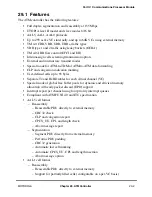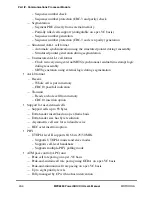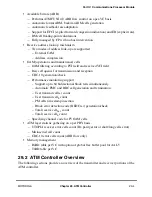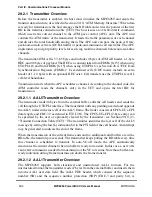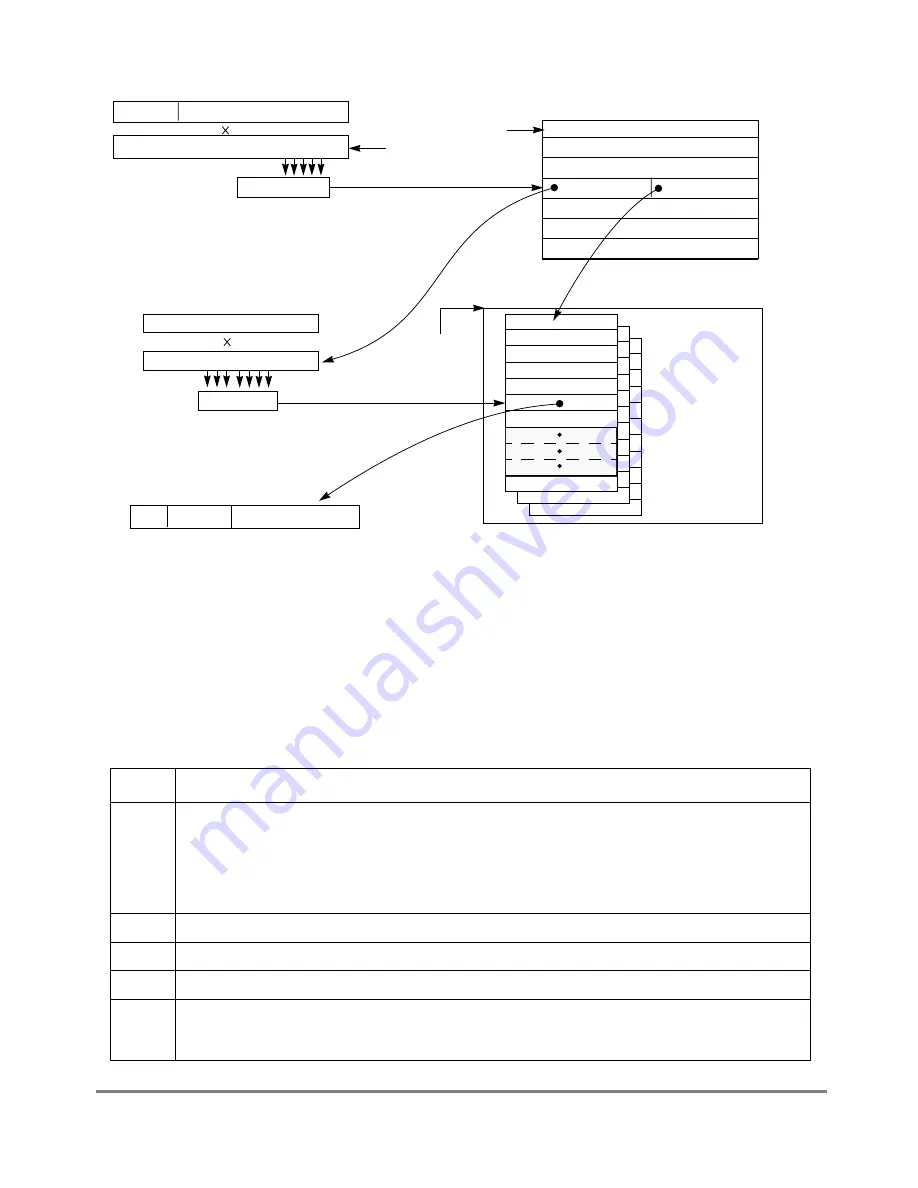
29-16
MPC8260 PowerQUICC II UserÕs Manual
MOTOROLA
Part IV. Communications Processor Module
Figure 29-5. Address Compression Mechanism
Figure 29-5 shows VP_MASK selecting Þve VPI bits to index the VP-level table. The VP-
level table entry contains the 16-bit mask (VC_MASK) and the VC-level table offset
(VCOFFSET) for the next level of address mapping. The VC_MASK selects VCI bits 4Ð
10, which is used with VCT_BASE and VCOFFSET to indicate the received cellÕs channel
code.
Table 29-3. Field Descriptions for Address Compression
Field Description
PHY
Addr
In multiple PHY mode, this Þeld contains the 4 least-signiÞcant bits of the current channelÕs physical
address. Because this comparison Þeld is limited to 4 bits, two sets of look-up tables are needed if using
more than 16 PHYs.The msb of the PHY address lines (bit 4) selects between the two sets of tables. If the
msb is zero, the CP accesses the tables at VPT_BASE and VCT_BASE; if the msb is set, the CP uses
VPT1_BASE and VCT1_BASE. See Section 15.4.1, ÒCMX UTOPIA Address Register (CMXUAR).Ó
In single PHY mode, clear this Þeld.
VCI, VPI
The VCI and VPI of the current channel.
Ch Code Pointer to internal or external connection table.
Ñ
Reserved, should be cleared.
MS
Match status.
0 Match was found.
1 Match was not found.
32-bit entries
VP-level addressing table
VPI
0000
00011111
VPpointer
VPT_BASE
VCOFFSET
VC_MASK
VCI
00000111 11110000
VCpointer
32-bit entries
VC-level addressing tables
VCT_BASE
VP_MASK
16 bit
16 bit
PHY Addr
0000
16 bit
12 bit
4 bit
(in external memory)
(in dual-port RAM recommended)
Ch Code[15Ð0]
Ñ
16 bit
15 bit
MS
1 bit
31
0
31
0
0b00011
Summary of Contents for MPC8260 PowerQUICC II
Page 1: ...MPC8260UM D 4 1999 Rev 0 MPC8260 PowerQUICC II UserÕs Manual ª ª ...
Page 66: ...lxvi MPC8260 PowerQUICC II UserÕs Manual MOTOROLA ...
Page 88: ...1 18 MPC8260 PowerQUICC II UserÕs Manual MOTOROLA Part I Overview ...
Page 120: ...2 32 MPC8260 PowerQUICC II UserÕs Manual MOTOROLA Part I Overview ...
Page 138: ...Part II iv MPC8260 PowerQUICC II UserÕs Manual MOTOROLA Part II Configuration and Reset ...
Page 184: ...4 46 MPC8260 PowerQUICC II UserÕs Manual MOTOROLA Part II ConÞguration and Reset ...
Page 202: ...Part III vi MPC8260 PowerQUICC II UserÕs Manual MOTOROLA Part III The Hardware Interface ...
Page 266: ...8 34 MPC8260 PowerQUICC II UserÕs Manual MOTOROLA Part III The Hardware Interface ...
Page 382: ...10 106 MPC8260 PowerQUICC II UserÕs Manual MOTOROLA Part III The Hardware Interface ...
Page 392: ...11 10 MPC8260 PowerQUICC II UserÕs Manual MOTOROLA Part III The Hardware Interface ...
Page 430: ...Part IV viii MOTOROLA Part IV Communications Processor Module ...
Page 490: ...14 36 MPC8260 PowerQUICC II UserÕs Manual MOTOROLA Part IV Communications Processor Module ...
Page 524: ...17 10 MPC8260 PowerQUICC II UserÕs Manual MOTOROLA Part IV Communications Processor Module ...
Page 556: ...18 32 MPC8260 PowerQUICC II UserÕs Manual MOTOROLA Part IV Communications Processor Module ...
Page 584: ...19 28 MPC8260 PowerQUICC II UserÕs Manual MOTOROLA Part IV Communications Processor Module ...
Page 632: ...21 24 MPC8260 PowerQUICC II UserÕs Manual MOTOROLA Part IV Communications Processor Module ...
Page 652: ...22 20 MPC8260 PowerQUICC II UserÕs Manual MOTOROLA Part IV Communications Processor Module ...
Page 668: ...23 16 MPC8260 PowerQUICC II UserÕs Manual MOTOROLA Part IV Communications Processor Module ...
Page 758: ...27 28 MPC8260 PowerQUICC II UserÕs Manual MOTOROLA Part IV Communications Processor Module ...
Page 780: ...28 22 MPC8260 PowerQUICC II UserÕs Manual MOTOROLA Part IV Communications Processor Module ...
Page 874: ...29 94 MPC8260 PowerQUICC II UserÕs Manual MOTOROLA Part IV Communications Processor Module ...
Page 920: ...31 18 MPC8260 PowerQUICC II UserÕs Manual MOTOROLA Part IV Communications Processor Module ...
Page 980: ...A 4 MPC8260 PowerQUICC II UserÕs Manual MOTOROLA Appendixes ...
Page 1002: ...Index 22 MPC8260 PowerQUICC II UserÕs Manual MOTOROLA INDEX ...
Page 1006: ......

